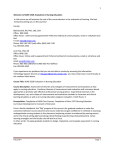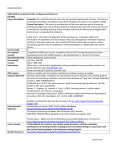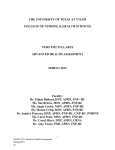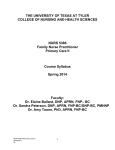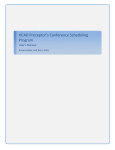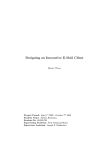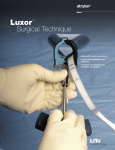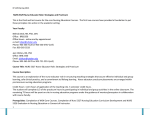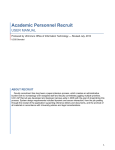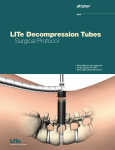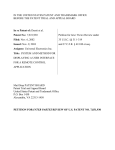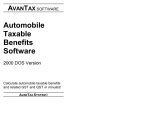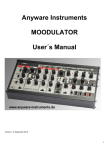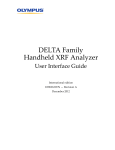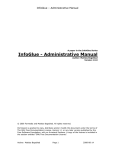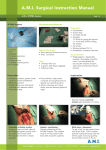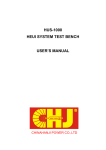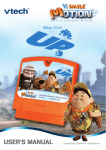Download NURS 5222 Diagnostic Methods and Procedures Course Syllabus
Transcript
THE UNIVERSITY OF TEXAS AT TYLER COLLEGE OF NURSING AND HEALTH SCIENCES NURS 5222 Diagnostic Methods and Procedures Course Syllabus Summer 2014 Course Faculty Dr. Linda Rath, PhD, RN, APRN Carol Price, RN, FNP‐BC Angie Corley, RN, FNP‐BC Additional Faculty, TBD Dr. Marcie Crisp, DNP, APRN, FNP‐C Summer, 2014 Syllabus Nurs 5222 Diagnostic Methods and Procedure TABLE OF CONTENTS Course Instructors……………………… Description………………………………… Overview…………………………………… Objectives…………………………………. Instructional Methods………………… Evaluation/Grading……………………. Required Resources………………….. Module Overviews……………………. Clinical Experiences…………………… Communication Log………. Typhon…………………………… Clinical Hours & Sites……… Attendance, Class…………. Participation, Professionalism Other Important Information…….. Assignments, Turn‐in……… Process Name Badges…………………. Preceptors……………………… Communication…………….. Polices and Expectations…………… Important University Dates & Policies………………………………………. Technical Information………………… …………………………………………………….3 …………………………………………………….3 …………………………………………………….4 …………………………………………………….4 …………………………………………………….4 …………………………………………………….5 …………………………………………………….6 …………………………………………………….7 …………………………………………………….8 …………………………………………………….8 …………………………………………………….8 …………………………………………………….9 …………………………………………………..10 …………………………………………………..10 …………………………………………………..10 …………………………………………………..11 …………………………………………………..11 …………………………………………………..12 ………………………..…………………………13 …………………………………………………..13 …………………………………………………..16 2 Summer, 2014 Syllabus Nurs 5222 Diagnostic Methods and Procedure WELCOME Welcome to NURS 5222‐ Diagnostic Methods and Procedures. Your instructors for this course are Dr. Linda Rath, Ms. Carol Price, Ms. Angie Corley, and TBD. In this course, you will be introduced to the diagnostic methods and procedures needed to formulate differential diagnoses. COURSE INSTRUCTORS Dr. Linda Rath, PHD, RN, NNP‐BC Email: [email protected] Work Phone: 903‐565‐5526 Office Location: GNOAC 119 Office Hours: By appointment and on‐line Contact preference: Prefer email Ms. Carol Price, MN, APRN, FNP‐C Email: [email protected] Phone: 903‐566‐7027 Office Location: BRB 2280 Office Hours: By Appointment and on‐line Contact preference: Prefer email Ms. Angie Corley, MSN, APRN, FNP‐BC Adjunct Faculty Email: [email protected] Phone: 713‐397‐9773 Office Hours: By appointment and on‐line Contact preference: Prefer email Dr. Marcie Crisp, DNP, APRN, FNP‐C Assistant Professor Email: [email protected] Phone: Office – 903‐565‐5954 / Cell – 325‐864‐2497 Office Location: BRB 1105 Office Hours: By Appointment and on‐line Contact preference: Prefer email or Cell phone New Faculty, TBD Course Description This course presents the advanced practice nursing (APN) student with selected clinical diagnostic laboratory and imaging tests and with selected procedures practiced by APNs. Clinical decision making for selecting appropriate tests or procedures, and interpretation of diagnostic test results is addressed. Students will use evidence based research to appropriately gather, interpret, and manage objective diagnostic clinical data to manage various health problems across the lifespan. 3 Summer, 2014 Syllabus Nurs 5222 Diagnostic Methods and Procedure Overview This course builds on previous knowledge of basic microbiology, physiology, and clinical practice. The focus of the course is application of diagnostic methods and procedures typically carried out by APNs in various practice roles and sites. Didactic content addresses selected common laboratory and imaging tests applicable to APN practice, the rationale for these tests, expected results and common abnormal results. Clinical experience focuses on selection of appropriate diagnostic tests, collecting specimens, analyzing selected tests and evaluating results. Clinical content also presents opportunities for students to practice procedures commonly carried out by APNs in various sites and specialties. Objectives Upon completing this course, the learner will have demonstrated the ability to: 1. Select appropriate diagnostic tests and procedures for conditions commonly seen by APRNs. 2. Perform selected procedures. 3. Provide rationale for test and/or procedure selection, based on health assessment data, clinical signs and symptoms, cost, risk/benefit analysis. 4. Discuss ethical, legal, and regulatory considerations related to selecting, collecting, and evaluating diagnostic tests and procedures. 5. Collaborate with physicians, laboratory personnel, clients and other health care providers, as necessary, to select and carry out appropriate diagnostic tests and/or procedures. 6. Interpret results of diagnostic tests for clinical decision making. 7. Evaluate performance of procedure. 8. Recognize reimbursement procedures related to selected diagnostic tests and procedures. INSTRUCTIONAL METHODS This course is taught in a web‐enhanced format with online readings as well as scheduled on campus lecture and labs throughout the semester. The following learning experiences are included: Online learning activities and website media will be used. Mandatory face‐to‐face lecture and labs will be held several times during the semester for intensive focus on advanced assessment skills. Clinical experiences with preceptors will enhance the application and practice of skills. If you are unable to attend any session because of an emergency situation, you must make prior arrangements with Dr. Rath [[email protected]] and your clinical instructor. 4 Summer, 2014 Syllabus Nurs 5222 Diagnostic Methods and Procedure COURSE ELEMENTS A student’s achievement of the course objectives is evaluated based on the following activities: COURSE EVALUATION Grades and Grading Evaluation/Grading Method is as follows: Course Grading Scale: A = 90 to 100% B = 80 to 89% C = 70 to 79% D = 60 to 69% F = Below 60% GRADING ELEMENTS Module quizzes (3) 10% each Completion of Radiology Course (assigned online modules) Completion of EKG Interpretation Modules (online‐10% each) Clinical Schedule Clinical Objectives Communication Log (1) Typhon submissions Clinical summary form Preceptor Evaluations POINTS 30% 35% 35% P/F P/F P/F P/F P/F P/F LATE PAPERS All late assignments may be assessed a 5 points per day penalty (including week‐ends) when the assignment is not posted by the due date and specified time unless prior arrangements are made with the instructor. All papers are due by the time (Central Standard Time) specified in the Course Calendar. Assignments must be posted via the assignment icon on Blackboard – NOT by email. Quizzes The purpose of the module quizzes is to evaluate the extent to which the module objectives have been met by the student. The module quizzes will be taken on Blackboard. It is expected that the student will exhibit academic integrity when taking the quizzes. **THE MODULE QUIZZES ARE NOT A GROUP EXERCISE and it is expected that the students will do their own work. Module quizzes will consist of multiple choice and short answer questions. Quizzes will be available as noted on the calendar. Quizzes are open for multiple attempts. Please email your instructor if you have any problems accessing the quizzes. 5 Summer, 2014 Syllabus Nurs 5222 Diagnostic Methods and Procedure REQUIRED RESOURCES American Psychological Association. (2009). Publication manual of the american psychological association (6th ed). Washington, D.C.: American Psychological Association. (ISBN: 978‐1‐4338‐ 0561‐5). (Note: A useful resource can be found at the following Internet site: http://www.apastyle.org) Goolsby, M., & Grubbs, L. (2008). Advanced assessment: Interpreting findings and formulating differential diagnoses. (2nd Ed.). ISBN: 978‐0‐8036‐2172‐5 AUTHOR Dubin (2000) Edmunds (2003) Fischbach (2009) Erkonen/Smith (2009) Anderson, B.C. (2006) Trotter Eiff/Hatch/Culmbach (2011) Mccaffrey & Youngkin TITLE Rapid Interpretation Of Ekg's Procedures For Primary Care Practitioners Manual Of Laboratory & Diagnostic Tests Radiology 101 (2010) Office Orthopedics For Primary Care: Treatment & Diagnosis Package Wounds & Laceration Fracture Management In Primary Care NP Notes: NP Clinical Pocket Guide ED. PUBLISHER ISBN STATUS 6th Cover/ 9780912912066 Required 2nd Elsevier/ 9780323016193 Required 8th Lippincott/ 9780781771948 Required 3rd Ed. Lippincott 9781605472256 Required 978‐1416035954 3rd Ed Required 4th Ed. Elsevier 9780323074186 Required 3rd Ed. Saunders 978‐1437704280 Recommended 2nd Ed. 978‐0803639089 Recommended 6 Summer, 2014 Syllabus Nurs 5222 Diagnostic Methods and Procedure READING/TIME FOR COMPLETION OF ASSIGNMENTS Reading of professional materials (books, journals, etc.) is an integral aspect of role development as a nurse practitioner. It is recommended that students spend a minimum of 2 hours daily reading materials related to assigned readings, clinical topics, and professional issues associated with the NP role and competencies. As a rough guide, you should plan to spend six to ten hours per week on this course. The actual amount of time will vary from individual to individual. This estimate includes the time you spend in reading, discussions, and assignments Each participant is responsible for completing the modules and reading assignments in a timely manner. Reading assignments will be listed for each module. Discussion and written assignments are made with the assumption that required reading assignments will be completed prior to completion of discussion and written assignments. MODULE OVERVIEWS For a complete list of module assignments, please go to Course Documents on Blackboard. Module One‐‐Common Procedures Overview: Procedures commonly performed for management of health problems are the focus of this module. The learner is introduced to a variety of technical procedures. Many of these procedures will be reviewed during the campus intensives noted in the course calendar. Module Two‐‐Laboratory Regulations and Procedures Overview: Federal Rules for clinical lab operation relevant in health care govern aspects of the advanced practice nurse’s activity in daily practice. Collecting specimens and performing some lab studies or supervising others who do so may also be practice responsibilities. Ethical and legal considerations must also be taken into account when ordering, collecting, performing, interpreting and reporting diagnostic tests. Module Three‐‐Common Laboratory Studies Overview: Common clinical laboratory studies relevant to diagnosis and monitoring of health problems are presented in this module. Emphasis is on the data resulting from the tests and their relevance/appropriateness in clinical decision making commonly encountered in the office setting. This module considers these aspects of health care. Module Four‐‐EKG Interpretation Overview: The Module is designed to guide students through EKG interpretation or to improve EKG interpretation skills. Refer to Course Announcements as the semester progresses for information regarding access to materials for this module. 7 Summer, 2014 Syllabus Nurs 5222 Diagnostic Methods and Procedure Module Five‐‐Diagnostic Imaging and Radiology Overview: Imaging studies performed for clinical decision making in health care are the focus of this module. The learner is introduced to techniques for interpretation of chest and skeletal x‐rays as well as appropriate use of other imaging tests. Read with comprehension each chapter of the Radiology 101 textbook. Then complete the free (assigned) modules at this web address: http://www.med‐ ed.virginia.edu/courses/rad/ Access the link above and complete each of the modules listed below by due dates in the course calendar: Chest Radiology Plain Chest Radiograph Cardiac Radiography Gastrointestinal Radiology Plain Abdominal Radiograph Cross‐sectional Abdomen Cross‐sectional Female Pelvis Cross‐sectional Male Pelvis Genitourinary Radiology Imaging of the Cervical Spine Skeletal Trauma Pediatric Radiology Critical Thinking & Technology Assessment Quiz questions will be drawn from these materials and your reading, so study these resources carefully. Module Six‐‐Urgent Laboratory Studies Overview: Urgent clinical laboratory studies relevant to diagnosis and monitoring of health problems are presented in this module. Emphasis is on the data resulting from the tests and their relevance/appropriateness in clinical decision making commonly encountered in the urgent care setting. This module considers these aspects of health care. CLINICAL EXPERIENCES Communication Logs One communication log will be required. The submitted log will be pass/fail. You will find the template for communication log in the Clinical Forms section in the Course Information section of the menu. Typhon Throughout the NP Program, you will be asked to keep track of your clinical hours in a system called Typhon. Each student will provide an accurate and complete listing of all patients cared for during the course. In addition, all clinical hours completed should be logged into Typhon. Entries should be posted within one week of the clinical experience. Typhon will be evaluated by your instructors at mid‐term and at the end of the course, and periodically throughout the course. 8 Summer, 2014 Syllabus Nurs 5222 Diagnostic Methods and Procedure Fabrication of entries is academic misconduct. Enter patient data accurately and completely into Typhon. Typhon requires demographic data and diagnoses for each patient. Each student should keep a printout or burn a CD of your clinical logs (or both). These logs may be requested by the Board of Nursing if you move to another state and request approval as an APN there. It is the responsibility of the student to keep these logs – THEY WILL NOT BE KEPT BY THE UNIVERSITY. CLINICAL HOURS A minimum of 45 clinical hours is required for satisfactory completion of this course and a total of 675 clinical hours for the entire program. The breakdown of clinical hours is as follows: Pediatrics – 150 hours Women’s Health – 75 hours Family Practice – 450 hours One half of all hours for the program must be completed with a Nurse Practitioner preceptor. The remainder of your clinical hours may be completed with a physician (MD or DO) or PA. PA’s MAY BE USED AS A PRECEPTOR. An emergency room or urgent care setting is most appropriate for this course, to allow students to practice their skills. It is also recommended that you spend some time with a radiologist, if at all possible. Remember, 45 hours is the minimum amount of time spent, but you can do more hours. However, hours cannot be “banked” for use in future courses. So, for example even if you complete 60 hours during this course, you will only be allowed to count 45 hours toward the total 675 hours. The reason for this is that each course is independent and the hours calculated are based on the ratio of didactic to clinical time. You must have approval from your clinical faculty for any clinical setting and preceptor you will be working with, prior to starting any clinical hours. Please use the facility agreement and preceptor forms that can be found at the NP website under Student Resources. There is a link to these forms on Blackboard for your convenience. Forms must include all information in order to be processed. You are expected to log your hours in Typhon throughout the semester. Please download and save a copy for your records and upload a copy of your TIME LOGS via the assignment link. In addition, complete the Summary of Clinical Hours form that is located under "Clinical Documents" on Blackboard. Experiences available to the student will depend on the clinical site and preceptor. However, here is a partial list of those experiences which the student should seek to do under supervision: Obtaining patient informed consent prior to any procedure. Assessing lacerations, tears, abrasions. Suturing (subcuticular and epidermal) various areas and on patients of venous demographics, including Pedi., including patient education Ring block anesthesia of digit Infiltration of local anesthetic Punch biopsy Assessment of orthopedic complaints for fracture, including reading x‐rays. Splinting, casting or taping extremities with appropriate patient education. Assessment of ingrown toenails and subsequent infection 9 Summer, 2014 Syllabus Nurs 5222 Diagnostic Methods and Procedure Excision of toenails Assessing patient prior to ordering chest, abdominal and other radiological tests Interpreting radiological tests, with preceptor, and determining treatment plan. Perform wet mounts, microscopic urinalysis, and other specimens and interpret results with preceptor. Order and interpret spirometry tests, laboratory tests on various body fluids and other diagnostic tests, as appropriate. Students should be aware that faculty may contact preceptors at any time to discuss the student’s progress or make unannounced site visits. Students are responsible to notify faculty as well as preceptors if there is any change made to their clinical schedule. Attendance/Class Participation/Professionalism Graduate students at The University of Texas at Tyler are held to a high standard of professionalism. The UT Tyler student represents not only themselves, but the University as well. Professionalism issues include, but are not limited to the following: 1) timely attendance to class or clinical activities (tardiness); 2) appropriate dress and behavior in class and clinical activities (includes turning off cell phones and pagers, and appropriate grooming and attire both in the classroom, and in the clinical area); 3) leaving class or clinical area to answer phone or make calls; 4) adherence to the Academic Honesty policy of UT Tyler and course syllabus; 5) repeated absences or tardiness to class or clinical activities; 6) failure to notify the faculty or preceptor about changes in the preceptor agreement; 7) tardiness to the clinical site; and 8) failure to adhere to the clinical dress policy. Students are expected to arrive on time to class and to their clinical sites. Points will be deducted from the student’s overall grade for consistent tardiness or absences. In addition, students are expected to dress in professional attire (No jeans, or open‐ toed shoes) and wear a white lab coat with the UT Tyler patch on the Left Sleeve. Note: Scrubs may be the required professional attire in some urgent care clinics and ERs. Please follow the facilities’ dress code, and also wear your lab coat. Clinical decision‐making and diagnostic reasoning must be mastered by the nurse practitioner. The expectation is that students will demonstrate appropriate professional interaction and discussion of clinical experiences, as well as information from reading/studying didactic information. Lack of student discussion and/or class participation may result in deductions from the course grade. As adult learners, graduate students are responsible to attend all classes and clinical experiences. Students who have emergency situations should contact the course facilitator and assigned clinical faculty/clinical preceptor as soon as possible. Since class attendance is mandatory, missing class may result in a reduction in the course grade. OTHER IMPORTANT INFORMATION Assignments/Projects Turn‐In Process All assignments and projects will be submitted through the assignments link. Use the following process to prepare and submit assignments: 10 Summer, 2014 Nurs 5222 Syllabus Diagnostic Methods and Procedure Prepare your assignment using Microsoft Word. Name your assignment with the following convention: First initial, Last name, Assignment title, Course Number (ex. MSmithPediatricCaseStudyN5352) Click on "View/Complete Assignment" in the modules overview area or project area Number 1‐shows the assignment instructions Number 2‐is where you add your comments and attach your completed assignment Number 3‐when all attached files (your completed assignment files) are uploaded, click submit When assignments are received, we will open them in Microsoft Word for grading. This will enable us to make comments, ask questions, etc. We will then return your assignment through the Student Grade book area. To see comments about your assignment, click on your grade. If you need more instructions on how to submit files through the assignment link in the modules, please read the Blackboard Student Manual located in the Tools area. All student assignments should be posted for evaluation using the assignment icon in Blackboard. Graded assignments will be posted there also unless your clinical faculty makes alternate arrangements with the student. Name Badges Nurse Practitioner students are to wear their Name Badges whenever they are in the clinical setting, and on‐campus for labs. Preceptors This course requires 45 clinical hours in addition to the didactic content. Students are required to find their own preceptors. Before a student can begin their clinical hours, a signed preceptor agreement and a clinical facility agreement must be submitted to Lindsey Heaton, Grad Nurse Recruiter. If the clinical site already has a facility agreement with UT Tyler on file, another one is not necessary, however, a signed preceptor agreement is still needed. If a facility agreement is not on file, it may take some time to get this accomplished, so start this process as early as possible. This information is provided to help you plan your clinicals, so that you are not waiting for approval. A list of preceptors that have clinical facility agreements on file is available in the NP program office to help you with this process and will be loaded onto blackboard. The preceptor agreement form is included. If a facility agreement needs to be initiated, please complete the Facility Agreement Information document available on the course web page and email it to Lindsey Heaton, Grad Nurse Recruiter as quickly as possible at the beginning of the summer semester. This will help to expedite the process. Your clinical instructor must approve your preceptors and your clinical schedule prior to beginning any clinical hours. Students are strongly encouraged to begin making contacts with potential preceptors now, in order to begin your clinical hours once you have actually started the course. In order to meet the learning objectives, you may choose to work with physicians, physician assistants, and nurse practitioners at a setting that meets your educational needs for the 11 Summer, 2014 Syllabus Nurs 5222 Diagnostic Methods and Procedure semester. Please remember that you are not allowed to do your clinical where you are employed. Each course has specific focus for clinical, and clinical sites/preceptors must be approved by your clinical instructor. A Preceptor Handbook is available on Blackboard for students to give to your preceptors. In addition, students are expected to develop specific clinical objectives and provide those to each of your preceptors at the beginning of your clinical rotations—see course calendar. COMMUNICATION With Preceptors Clarity in communication is absolutely critical to the professional role, especially for the advanced practice nurse. Communicate clearly with preceptors about your objectives, learning needs, and clinical hours. Preceptors provide feedback to the student and the faculty about the student’s clinical performance. With Faculty Regular communication with the clinical faculty is required to review clinical activities, develop on‐going objectives, and evaluate clinical progress. On Blackboard Students are to check the Announcement section of Blackboard daily for announcements and new information. Students may also post questions in the designated discussion areas to other students or the course faculty. Patriot Email Students must check their Patriot email on a regular basis. This is the preferred method of communication by faculty with students. Failure to check your email may result in a lack of feedback regarding course changes and other important information. Email: To communicate by email within the course with other participants or all participants, click the Communications link on the left. Click Send E‐mail to send a message. You are able to send messages to All Users or Select Users in the course, including the instructors. If you need more instructions on how to send email messages with Blackboard please read the student manual located in the Resources area of the course. Questions or problems other than technical problems (see Technical Requirements in this Syllabus) may be submitted to the email addresses above. You can expect to receive responses to any emails you send within a 48 hrs time period Monday through Friday during business hours (9‐6). Faculty will not be available to reply to emails or phone calls after 6pm or over the weekends. If our schedules will make us unavailable to answer emails for a day or two, we will send an announcement out so that you can plan accordingly. Technical problems in email systems may slow down responses. 12 Summer, 2014 Syllabus Nurs 5222 Diagnostic Methods and Procedure POLICIES AND EXPECTATIONS Accessing Library Resources Students enrolled in this course have several options to access library resources. You may visit your home campus library or the Robert R. Muntz Library at the University of Texas at Tyler. Follow this link, and then complete the instructions at those sites for accessing information from a distant site. Course Evaluation The University of Texas at Tyler requests that students complete a voluntary evaluation of both the faculty and the course. Students who complete the online evaluations by the deadline will have early access to their grades on myUTTyler. Evaluations are used to make improvements and adjustments in overall learning forums. Your comments and recommendations will be seriously considered as the course is updated. Your input throughout the semester allows faculty to improve the quality and relevance of this course on a continual basis. IMPORTANT UNIVERSITY DATES: JUNE 9, 2014 – CLASSES BEGIN; Late registration and schedule changes. JUNE 12 2014 – CENSUS DATE (4TH CLASS DAY): Deadline for all registrations, schedule changes, and section changes. JUNE 30, 2014 –LAST DAY TO WITHDRAW PASSING JULY 4, 2014 – INDEPENDENCE DAY HOLIDAY AUGUST 15, 2015 – FINAL GRADES DUE IN FACULTY CENTER BY 12:00 NOON IMPORTANT UNIVERSITY POLICIES http://www.uttyler.edu/academicaffairs/syllabuspolicies.pdf Students Rights and Responsibilities To know and understand the policies that affect your rights and responsibilities as a student at UT Tyler, please follow this link: http://www.uttyler.edu/wellness/rightsresponsibilities.php Graduate Nursing Student Handbook It is the responsibility of each graduate nursing student to read the Graduate Nursing Student Handbook. The section for a Master’s Degree begins on page 29. It is especially important that students be aware of the selected excerpt below regarding program progression: Progression MSN requirements for progression include the following: 1. A minimum grade of “B” is necessary in all required courses for the MSN degree. Students have the responsibility of monitoring grades in the course websites in Blackboard throughout the semester and in communicating with course instructors 13 Summer, 2014 Syllabus Nurs 5222 Diagnostic Methods and Procedure regarding grade status. Two course failures will result in dismissal from the program. 2. Core courses must be taken in sequence, as indicated in the U.T. Tyler catalog. 3. Students on conditional admissions status will be granted full acceptance status after the successful completion of designated coursework prior to petitioning the Graduate Studies Committee for a change in admission status. 4. Nursing courses within the MSN curriculum may be repeated only once. A course withdrawal is counted as one course attempt. Grade Replacement/Forgiveness and Census Date Policies Students repeating a course for grade forgiveness (grade replacement) must file a Grade Replacement Contract with the Enrollment Services Center on or before the Census Date of the semester in which the course will be repeated. Grade Replacement Contracts are available in the Enrollment Services Center or at http://www.uttyler.edu/registrar. Each semester’s Census Date can be found on the Academic Calendar, or in the information pamphlets published each semester by the Office of the Registrar. Failure to file a Grade Replacement Contract will result in both the original and repeated grade being used to calculate your overall grade point average. Undergraduates are eligible to exercise grade replacement for only three course repeats during their career at UT Tyler; graduates are eligible for two grade replacements. Full policy details are printed on each Grade Replacement Contract. Census Date The Census Date is the deadline for many forms and enrollment actions that students need to be aware of. These include: Submitting Grade Replacement Contracts, Transient Forms, requests to withhold directory information, approvals for taking courses as Audit, Pass/Fail or Credit/No Credit. Receiving 100% refunds for partial withdrawals. (There is no refund for these after the Census Date) Schedule adjustments (section changes, adding a new class, dropping without a “W” grade) Being reinstated or re‐enrolled in classes after being dropped for non‐payment Completing the process for tuition exemptions or waivers through Financial Aid State‐Mandated Course Drop Policy Texas law prohibits a student who began college for the first time in fall 2007 or thereafter from dropping more than six courses during their entire undergraduate career. This includes courses dropped at another 2‐year or 4‐year Texas public college or university. For purposes of this rule, a dropped course is any course that is dropped after the census date (See Academic Calendar for the specific date). Exceptions to the 6‐drop rule may be found in the catalog. Petitions for exemptions must be submitted to the Enrollment Services Center and must be accompanied by documentation of the extenuating circumstance. Please contact the Enrollment Services Center if you have any questions. 14 Summer, 2014 Syllabus Nurs 5222 Diagnostic Methods and Procedure Disability Services In accordance with federal law, a student requesting accommodation must provide documentation of his/her disability to the Disability Services counselor. If you have a disability, including a learning disability, for which you request an accommodation, please contact the Disability Services office. Student Absence due to Religious Observance Students who anticipate being absent from class due to a religious observance are requested to inform the instructor of such absences by the second class meeting of the semester. At that time the instructor will set a date and time when make‐up assignments will be completed. Student Absence for University‐Sponsored Events and Activities If you intend to be absent for a university‐sponsored event or activity, you (or the event sponsor) must notify the instructor at least two weeks prior to the date of the planned absence. At that time the instructor will set a date and time when make‐up assignments will be completed. Social Security and FERPA Statement: It is the policy of The University of Texas at Tyler to protect the confidential nature of social security numbers. The University has changed its computer programming so that all students have an identification number. The electronic transmission of grades (e.g., via e‐mail) risks violation of the Family Educational Rights and Privacy Act; grades will not be transmitted electronically. Emergency Exits and Evacuation: Everyone is required to exit the building when a fire alarm goes off. Follow your instructor’s directions regarding the appropriate exit. If you require assistance during an evacuation, inform your instructor in the first week of class. Do not re‐enter the building unless given permission by University Police, Fire department, or Fire Prevention Services. Student Services (903) 566‐7254 The goal of the Student Services Program is to offer a broad range of interventions that may be used by students who wish to improve their academic performance or by those who are on academic probation. The Learning Strategies Program offers the Learning and Study Strategies Inventory (LASSI), which helps students identify potential areas of improvement. These areas can range from: Study Strategies Finding the Main Idea Test‐Taking Skills Test Anxiety Note Taking Skills Once these areas are identified, a counselor will aid the student in creating an individualized program that the student may use to help improve his or her academic performance. The individualized program may consist of specific study and learning strategies, additional assessment, individual counseling or referrals to other campus services. 15 Summer, 2014 Syllabus Nurs 5222 Diagnostic Methods and Procedure TECHNICAL INFORMATION If you experience technical problems or have a technical question about this course, you can obtain assistance by accessing The UT Tyler Campus Computing Center. Computer Requirements‐Minimum hardware requirements and recommended software configurations o Ensuring you have the proper hardware and software is imperative to your success in an online course. The requirements are based on the results of testing conducted by Blackboard. Additional information is available at o http://wiki.uttyler.edu/pages/viewpage.action?pageId=1474652 What are the recommended computer requirements to access Blackboard? Blackboard Documentation and FAQ > FAQ > 128 MB of RAM. Microsoft Windows 2000, Microsoft Windows XP with the latest critical updates, or Microsoft Vista with the latest critical updates. (Note: you will need to turn the text box editor off if you are using Vista as described above.) Internet Explorer XP 7.0 with the default settings. (Note: you will need to turn the text box editor off if you are using Internet Explorer 7.) Microsoft Office XP and 2003 with the latest critical updates. In addition, you might need the following software installed: Adobe Acrobat Reader ‐ download it here for FREE Macromedia Flash Player ‐ download it here for FREE Note: If you do not want the Yahoo Tool Bar for your browser, uncheck the box BEFORE you download. Real Player ‐ download it here for FREE Note: An "installer" program will download first, and then you will be prompted to actually download the player. Quick Time Player ‐ download the Windows version here for FREE Note: If you do not want the newsletter subscriptions, uncheck the boxes. Windows Media Player ‐ download it here for FREE ** Note: You can buy Microsoft Windows XP and Microsoft Office 2003 at the UT Tyler bookstore at an affordable price. o Audio 16 bit or better sound card and speakers (if your course contains audio content) o Internet Connection 56.6 KBPS modem, cable modem, DSL, or intranet (T‐1) Note: Corporate or academic security firewalls may block some course content, such as chat or streaming media o Email Address Email is a vital communication medium in online learning. It is important that you have a working email address to receive communications from your 16 Summer, 2014 Syllabus Nurs 5222 Diagnostic Methods and Procedure advisor, instructors, and classmates. You are responsible for keeping your email address and other personal information up to date in the Tools Area, Personal Information section. o Virus Protection It is recommended that you protect your computer from viruses. Keep your antivirus software up to date with the latest virus updates. Antivirus and Personal Firewall products may be available to you for free or at a reduced price through the Campus Computing Center. Check with your ISP, network help desk, or search the Internet for more information and product resources. o Spyware & Adware Protection Spyware and Adware are fast‐growing threats that represent a major security and privacy risk. Spyware is a program that is installed, with or without the user's permission, and can monitor computer activity while broadcasting the information back to an outside party that controls the program. Adware displays unwanted advertising to your computer, can track your Web surfing habits and report it back to a central advertising server. It can slow your PC to a crawl by bombarding it with unwanted ads. Spyware and Adware removal tools and protection may be obtained through the Campus Computing Center or online resources. Browsers Download Safari o UT Tyler courses use Java, JavaScript, browser plug‐ins, helper applications and cookies. It is essential that you have these elements installed and enabled in your web browser for optimal viewing of the content and functions of your online course. o Unsupported Browsers‐America Online (AOL), Prodigy, Juno, MSN, Yahoo and other Internet Service Providers (ISPs), provide their own internal and proprietary web browsers. These browsers may not be compatible with UT Tyler courses. We strongly recommend downloading and installing one of the Blackboard supported browsers listed above to ensure optimal functionality with the elements of your online course. Note: It's not recommended to use IE on Macintosh since it is no longer supported by Microsoft. Plug‐ins and Helper Applications o Macromedia Flash Player allows you to view content created with Macromedia Flash such as interactive web applications and animations. o Shockwave Player allows you to view content created with Macromedia Director such as games and interactive 3D simulations. 17 Summer, 2014 Syllabus Nurs 5222 Diagnostic Methods and Procedure o RealPlayer allows you to view and listen to streaming video and audio. o QuickTime Player allows Mac and Windows users to play back audio and video files. o Windows Media Player allows you to view, listen and download streaming video and audio. o Adobe Reader allows you to view, save, and print Adobe Portable Document Format (PDF) files. o Sun Java Runtime Engine (JRE) allows you to use interactive tools on the web. o PowerPoint Viewer 2003 lets you view full‐featured presentations created in PowerPoint 97 and later versions. Tools Blackboard Academic Suite User Manual Resource detailing the tools and functions included as part of the Blackboard Academic Suite from the Student or general user perspective Getting Help ‐If you are having technical problems, please contact the Campus Computing Center: o Campus Computing Center Business 101 3900 University Blvd Tyler, TX 75799 (903) 566‐7367 [email protected] o 18


















